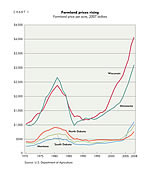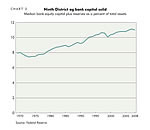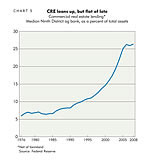Last year, prices for agricultural land and commodities reached record highs. A subsequent steep drop in crop prices has given some a queasy feeling of déjà vu, taking them back to the farm crisis of the 1980s, when operating losses on farms and a fall in agricultural land values led to the failure of hundreds of banks.
Those memories are still fresh in many rural communities—particularly among their bankers—for good reason. More than 40 percent of Ninth District banks are so-called ag banks, which the Federal Deposit Insurance Corp. defines as those with more than one quarter of their loans to farm operations or secured by farmland.
The similarities in agricultural conditions, coupled with the more general recent increase in bank failures, raise the specter of a repeat crisis for agricultural banks. Historical data provide a mixed message on its likelihood. On one hand, farmers and banks are financially strong, carrying lower debt loads and higher capital than ever before. But on the other hand, the overall level of risk to which banks are exposed might be greater than it was a generation ago.
Don’t remind me
Rewind to the 1970s. Crop prices jumped between 1972 and 1974, followed by a big increase in farmland prices (see Chart 1). Land values continued their ascent even as farm commodity prices fell through the latter part of the decade. Although crop prices rebounded somewhat in the opening years of the 1980s, they were not high enough for a long enough period to turn around eroding farm balance sheets.
By about 1982, low commodity prices ate away at profitability, especially for many farmers who had taken on significant debt when times were good. The Federal Reserve was also in the midst of raising interest rates significantly to put a lid on inflation, which further reduced the profitability and attractiveness of farmland as an investment. Land prices started falling. Once they did, low or negative profitability meant farmers could not repay their loans, and the dropping value of the farmland meant they also could not qualify for new loans in hopes of limping through until prices rebounded.
Foreclosures were widespread as land values fell throughout the mid-1980s. The loan portfolios that had allowed the banks to grow and prosper were suddenly bleeding red ink. Many ag banks, including 49 institutions in the Ninth District, eventually failed.
Some observers see worrisome similarities to the 1980s farm crisis in recent agricultural sector trends. For example, corn, wheat and soybeans—three key crops in district states—all doubled or tripled in price from 2006 to 2008, just as they did in the 1970s. Farmland prices, for their part, rose steadily throughout the decade and reached record highs in 2008. (For an in-depth look at rising farmland values in the district, see “Making hay off the land” in the July 2008 fedgazette.)
Just as before, commodity prices have fallen sharply off their highs, and evidence is now emerging that farmland prices have also begun to recede. For the first time since 2002, and by a convincing margin, respondents to the Minneapolis Fed’s fourth-quarter agricultural credit conditions survey expect land prices to decline. Some forecasters also see parallels in the current interest rate environment, believing that while real interest rates are low today, the Fed may at some point raise rates in response to emerging inflation; such a move could again lend a boost to falling farmland values.
The same, but different?
An examination of bank health and performance indicators for the two periods offers some insights regarding their similarities and differences. In some ways, it looks like the fallout from a severe downturn would be better contained today. But by other measures, the prognosis is worse.
One reason for optimism lies in the balance sheets of American farmers, who are less in debt than ever before. According to the United States Department of Agriculture, the ratio of farm debt to equity stood at 9.78 at the end of 2008—roughly half the average level (19.33) of the late 1970s (see Chart 2). Although state-level data are not available for any year after 2003, the Ninth District has historically followed national trends, and average debt levels had already reached record lows in the USDA’s last state-level reports. In contrast to the prevalence of high leverage three decades ago, debt prudence seems to carry the day for farmers now, and aggregate balance sheets look considerably stronger than in the past.
Balance sheets are also better at ag banks, where high capital levels look to provide better resistance to adverse conditions. A bank’s level of capital is strongly correlated with its ability to avoid failure—indeed, it’s the very definition of solvency. Average measures of capital at Ninth District ag banks dipped notably around 1976 (leading into the farm crisis), but have headed consistently upward for the past decade and stand roughly 50 percent higher today (see Chart 3).
Loan portfolio composition also hints at stronger risk management practices today. Research on the ag bank failures of the 1980s shows that the banks that preferred loans with a collateral claim against the farmer’s land over loans that simply finance farm operations were more successful at surviving the crisis. Banks that started off with more farmland loans than operating loans faced smaller losses when conditions deteriorated.
If that principle still holds, today’s ag banks measure up well. In fact, the average share of loans secured by farmland as a percentage of all ag loans has been on the rise since the 1980s, increasing from less than 10 percent to near 40 percent today (see Chart 4).
Furthermore, data indicate that ag banks have not expanded their balance sheets as much when prices were rising. Previous studies have found that failed ag banks had grown very quickly in the years preceding the crisis, with loan portfolios increasing at a rate of roughly 20 percent per year during the early 1970s. Portfolios have been much more conservative in recent years (see Chart 4). In the fallout from the crisis, it became clear that overenthusiastic lending was part of the problem—a mistake that bankers do not seem to have repeated this time around.
Ultimately, the strength of the industry as a whole depends a great deal on the overall strength of underwriting standards and other risk management practices at each individual bank. Aggregate ratings data from bank regulators suggest that ag banks are holding up well compared with other types of banks; more than 90 percent of ag banks still have a composite rating of 1 or 2 (the strongest ratings), while 84 percent of other types of commercial banks have composite ratings that strong.
Partly cloudy skies
Unfortunately, the data don’t support unbridled optimism. Anecdotal claims are difficult to compare with the available public data, in part because poorly performing banks are unlikely to trumpet their difficulties. A second glance at the supervisory data reveals that even though ag bank exam ratings are stronger than the ratings of other types of banks, they have nonetheless deteriorated. And agricultural prices only began heading downward in the past year, while supervisory ratings aren’t normally updated until the completion of a new exam, which may not occur every year.
Even the positive data on farm debt levels carry a caveat. Because farmland is one of the biggest assets a farm has, the debt-to-asset ratios that look so good today are extremely sensitive to changing land valuations. To the extent that falling land prices reduce the value of assets and equity on farm balance sheets, they will surely lead to rising debt ratios.
The 1980s data also point to some differences between surviving and failing banks that may raise concerns about today’s banks. A generation ago, banks that held a larger percentage of their assets in loans (rather than cash, securities or other conservative assets) were more likely to fail in the farm crisis. Yet for two decades, average loans-to-assets ratios have been on the rise. In this respect, the average contemporary ag bank resembles the banks that were headed for trouble in the 1980s.
Similarly, another significant characteristic of failed ag banks in the 1980s was that they tended to carry a greater portion of their securities portfolio in investments not backed by a federal guarantee, typically state and municipal securities. Although they didn’t necessarily lead to direct losses through default, their presence on the balance sheet appears to be a proxy for a bank’s overall appetite for risk. Those that sought more risk, at the margin, were the ones that tended to be most weakened in the crisis. Fast forward to today, and the ratio of non-federally guaranteed securities has risen steadily across the industry, which at least raises the question of whether banks are geared toward carrying higher levels of risk today.
What’s more, ag banks found trouble in the past when they lent outside of their primary specialty, as some of the banks that eventually failed did in the commercial and industrial (C&I) and commercial real estate (CRE) sectors in the 1980s. That doesn’t necessarily mean that lending of that type was extremely troubled, but perhaps that these banks were overextending themselves into businesses outside their areas of expertise. This time around, ag banks in general have become more invested in CRE lending (see Chart 5). This is troublesome not only because ag banks might be less well-versed in managing these loans, but also because there are emerging concerns about the poor performance of CRE lending in general.
The jury’s out
Stuff this all in a crystal ball, and it’s still hard to know whether any predictions will come true. To start with, no one can say for sure whether land and commodity prices will continue to fall. And there’s no clear answer about how well- prepared banks are in the event that they do.
Measures of the overall health of the industry are strong, and ag banks seem to have avoided the hallmarks of a “boom” mentality. Basic capital and debt ratios generally reflect well on the industry, and some characteristics of banks that successfully weathered the farm crisis are apparent in ag banks today. But some characteristics of failed banks from the previous farm crisis have also become more common over the past 20 years, possibly leading to increased sensitivity to changing conditions today.











